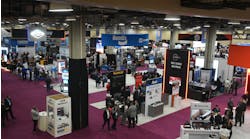[Editor’s note: This post first appeared in the August print edition of Trailer/Body BUILDERS.]
The economic challenges presented by the ongoing pandemic make for a worrisome near-term outlook, but the analysts featured in the latest seminar hosted by ACT Research suggest the cyclical nature of the commercial vehicle market points to a strong rebound. The wide-ranging event also featured discussion of trucking trends by carriers and dealers, alternative energy sources and alternative drivetrains for commercial vehicles.
Moving from an in-person to a virtual platform, ACT Research began its 63rd Seminar on Aug. 11, with a panel discussion about the current state and future of US economics.
Panelists included Patrick Manzi, chief economist for NADA, as well as ACT Principal and Industry Analyst Jim Meil, and Chief Economist Sam Kahan.
“Uncertainty, unpredictability, and vulnerability best describe the current forecasting environment,” Kahan said. “Pressure to automate will be intense, especially in the services sectors.”
“Long-term forecasts are inherently a shaky proposition,” Meil added. “But if history is any guide, the expansion that follows the COVID-recession will last well beyond 2025, perhaps reaching end-of-decade.”
Frank Maly, ACT director, CV Transportation Analysis & Research then discussed the US trailer market.
“Orders have improved after the COVID-driven lock-down levels of spring, but OEMs are still seeking to bring production into equilibrium with order placement,” Maly said. “However, there are indications of some ‘green shoots’ in the market that could be pointing toward improving times ahead.”
Regarding the North American medium-duty market, Steve Tam, ACT vice president noted the impact of home delivery of equipment decisions.
“Whether or not shifting last mile and home delivery patterns are changing medium duty truck buyers’ equipment specifications permanently continues to be clouded by uncertainty,” Tam said. “But as the market recovers, buyers are showing an obvious bias in favor of smaller vehicles.”
Tim Denoyer, ACT vice president and senior analyst, walked viewers through the explosion in truckload spot rates, what’s driving it, how it will be impacted by freight demand and capacity trends, and what all that means for the truck cycle.
Specifically, according to the August installment of the ACT Freight Forecast, U.S. Rate and Volume OUTLOOK report, a freight recovery amidst a driver shortage has driven an acutely tight truckload market, with spot rate measures up 30% y/y, Denoyer reported—but with latent equipment capacity and additional stimulus looking unlikely, “a peak seems near.”
“Looking forward, we now see a new phase of the pandemic, with tightness easing as stimulus benefits fade. The spike in used truck sales shows that process underway,” he said. “While the path ahead includes puts and takes, we see medium-term freight rate trends moving higher on tighter supply and recovering demand.”
Day Two
For the second day of ACT Research’s three-day virtual Seminar 63, alternative fuels—including hydrogen and electric—to power commercial vehicles were on the agenda, as was consideration of the future for diesel engines.
Mihai Dorobantu, Innovation & Advanced Technology executive from Eaton, discussed the future of hydrogen technology; Eric Fedewa, head of global market intelligence for Rhein Associates, spoke about key developments and the future of diesel engines; and Steve Slesinski, director of Global Product Planning for Dana Inc., shared thoughts about electrifying the medium duty market.
Industry experts’ opinions about efficiency, emissions, safety, connectivity, and regulations were some of the myriad of topics heard by the virtual audience. Additionally, ACT announced upgrades to its free, online total cost of ownership calculator, which now includes the societal costs in metric tons of CO2 per year. The calculator can be accessed by clicking here.
In addition to the alternative fuel sessions, ACT President and Senior Analyst Kenny Vieth spoke about current and future Class 8 equipment demand.
“On top of the continued steady roll out of good economic numbers, April’s driver capacity takeout has flipped the script on the supply-demand balance between capacity and freight. The resulting strong and sustained rally in spot rates was a key factor in this month’s forecast mark up,” Vieth said. “That said, parked drivers and parked trucks returning to the market are likely to put a temporary ceiling on rates as that capacity is redeployed throughout 2021.”
When asked about the COVID-19 impact on future demand, Veith noted that the ACT forecast assumes broad vaccination by mid-2021.
“At that point, the fuller economic reopening, pent-up demand for machinery, the need for inventory restocking, and healthy housing market fundamentals should set the table for the next strong heavy-duty upcycle,” he said.
Additionally, ACT Research has created an easily accessible COVID-19 MARKET WATCH web page to track noteworthy high frequency macroeconomic and transportation-specific market indicators, which can be found by clicking here.
Tam took the microphone again on Day Two, this time to share comments about the US used truck market.
“Even though excess freight hauling capacity and an oversupply of sleepers has conspired against used truck sellers, surprising economic resilience, and the subsequent growth in freight, looks like it might turn the market around sooner than previously expected,” Tam said.
Indeed, preliminary used Class 8 volumes (same dealer sales) grew 16% month-over-month in July, according to the latest preliminary release of the State of the Industry: U.S. Classes 3-8 Used Trucks published by ACT Research. Longer-term, volumes rose 48% compared to July 2019, and were up 7% when measured against the first seven months of last year.
Other data released in ACT’s preliminary report included month-over-month comparisons for July 2020, which showed that average prices increased 4%, while average miles and average age each decreased, down 4% and 1%, respectively, compared to June. Year-to-date, average price, miles, and age were all lower, down 17%, 2%, and 7%, respectively, compared to the first seven months of 2019.
“The upshot is that truck sales, both new and used, are performing at better than expected levels. That said, on the used truck side, this is curious, particularly given the number of trucking jobs that have been lost since COVID-19 started,” Tam concluded. “Unemployed truckers temporarily tighten capacity as their trucks are sidelined. This has led to increased freight rates, which has enticed first-time buyers to snap up equipment and jump into the fray.”
Day Three
The three-day virtual seminar concluded Aug. 13, when two panels were featured. The first considered current and future market trends from the perspective of dealers and truckers. Panelists included Jerold Richards, CFO of Classic Carriers, Oscar Horton, president/CEO of Sun State International Trucks, Robert Ragan, CFO of Melton Truck Lines, and Kerry Byrne, president of TQL.
The second panel discussed alternative power as panelists offered their takes on whether or not the 2020s will still be an electrifying decade for North American commercial vehicles or if there is going to be a different alternative. The discussion featured Don Jalbert, national sales director for Orange EV, Thomas Healy, founder and CEO of Hyliion, and Chris Nordh, senior director-Advanced Vehicle Technology & Energy Products for Ryder Systems.
Latest CV report
ACT Research holds two seminars per year for the benefit of its N.A. Commercial Vehicle OUTLOOK subscribers. The N.A. CV OUTLOOK is a robust report that forecasts the future of the industry, looking at the next 1-5 years, with the objective of giving OEMs, Tier 1 and Tier 2 suppliers, and investment firms the information needed to plan accordingly for what is to come.
According to ACT’s latest release, published in conjunction with the webinar, forecasts for 2020 were marked up across the board in August. The report cites the uptick as a result of a robust “perfect storm” of positives in late spring and summer, many set in motion by the federal government’s and the Federal Reserve’s massive stimulus responses, as well as the trucking industry’s jettisoning of drivers in April.
ACT’s 64th Seminar is scheduled for February 23-25, 2021. Focused on the continuous evolution and advancement of power and energy changes in the transportation and commercial vehicle markets, OUTLOOK Seminar 64 will feature key industry leaders such as Ryan Reed of Wabash National, John Bennett from Meritor, Lance Riegel of Marvin Johnson, and Dominick Beckman from Hino Motors. Look for more details on this event over the coming months and save the date for February’s event. When details are available, they may be found at www.actresearch.net/seminar64










